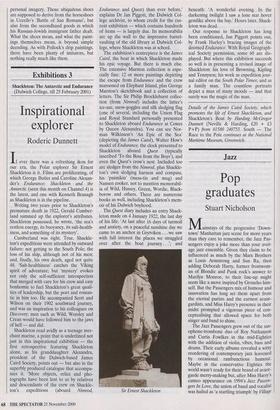Exhibitions 3
Inspirational explorer
Roderic Dunnett
If ever there was a refreshing ikon for our era, the Polar explorer Sir Ernest Shackleton is it. Films are proliferating, of which George Butler and Caroline Alexan- der's Endurance: Shackleton and the Antarctic (seen this month on Channel 4) is the latest, and one with Kenneth Branagh as Shackleton is in the pipeline.
Writing two years prior to Shackleton's premature death in 1922, Gerald Cumber- land summed up the explorer's attributes. Shackleton possessed, he wrote, 'the sea's restless energy, its buoyancy, its salt-health- iness, and something of its mystery'.
Cumberland was right. True, Shackle- ton's expeditions were attended by outward failure: not getting to the South Pole; the loss of his ship, although not of his men; and, finally, his own death, aged not quite 48. 'Salt-healthiness' catches the Viking spirit of adventure; but 'mystery' evokes not only the self-sufficient introspection that merged with care for his crew and easy bonhomie to fuel Shackleton's great quali- ties of leadership, but the poet and roman- tic in him too. He accompanied Scott and Wilson on their 1902 southward journey, and was an inspiration to his colleagues on Discovery; men such as Wild, Worsley and Crean would have followed him to the jaws of hell — and did.
Shackleton read avidly as a teenage mer- chant marine, a point that is underlined not just in this inspirational exhibition — the first retrospective featuring Shackleton alone, as his granddaughter Alexandra, president of the Dulwich-based James Caird Society, points out — but also in the superbly produced catalogue that accompa- nies it. 'More objects, relics and pho- tographs have been lent to us by relatives and descendants of the crew on Shackle- ton's expeditions (aboard Nimrod, Endurance and Quest) than ever before,' explains Dr Jan Piggott, the Dulwich Col- lege archivist, to whom credit for the cur- rent exhibition — which contains hundreds of items — is largely due. Its memorabilia arc up the wall to the impressive barrel- vaulting of the old library at Dulwich Col- lege, where Shackleton was at school.
The exhibition's centrepiece is the James Caird, the boat in which Shackleton made his epic voyage. But there is much else. The extensive Marston collection is espe- cially fine: 12 or more paintings depicting the escape from Endurance and the crew marooned on Elephant Island, plus George Marston's sketchbook and a collection of letters. The Sir Philip Brocklehurst collec- tion (from Nimrod) includes the latter's ice-axe, snow-goggles and silk sledging flag (one of several, including the Union Flag and Royal Standard personally presented to Shackleton aboard Endurance at Cowes by Queen Alexandra). You can see Nor- man Wilkinson's 'An Epic of the Sea' (depicting the James Caird), Walter How's mode] of Endurance, the clock presented to Shackleton aboard Quest (typically inscribed `To the Boss from the Boys'), and even the Quest's crow's nest. Included too are sledges from the Nimrod, plus Shackle- ton's own sledging harness and compass, his 'pannikin' (mess-tin and mug) and Nansen cooker, not to mention memorabil- ia of Wild, Hussey, Green, Wordie, Black- borow and others. There are numerous books as well, including Shackleton's mem- oir of his Dulwich boyhood.
The Quest diary includes an entry Shack- leton made oh 4 January 1922, the last day of his life: 'At last after 16 days of turmoil and anxiety, on a peaceful sunshine day we came to an anchor in Grytviken ... we saw with full interest the places we struggled over after the boat journey .'; and Sir Ernest Shackleton beneath: `A wonderful evening. In the darkening twilight I saw a lone star hover gemlike above the bay.' Hours later, Shack- leton was dead.
Our response to Shackleton has long been conditioned, Jan Piggott points out, by Frank Hurley's bracing images of the doomed Endurance. With Royal Geograph- ical Society permission, some 60 are dis- played. But where this exhibition succeeds so well is in presenting a revised image of Shackleton: his love of Browning, Kipling and Tennyson; his work as expedition jour- nal editor on the South Polar Times; and as a family man. The countless portraits depict a man of many moods — and that surely was the magic of the man.
Details of the James Caird Society, which promotes the life of Ernest Shackleton, and Shackleton's Boat by Harding McGregor Dunnett (Neville & Harding, £20 + £3 P+P) from 01580 240755. South — The Race to the Pole continues at the National Maritime Museum, Greenwich.





























































































 Previous page
Previous page